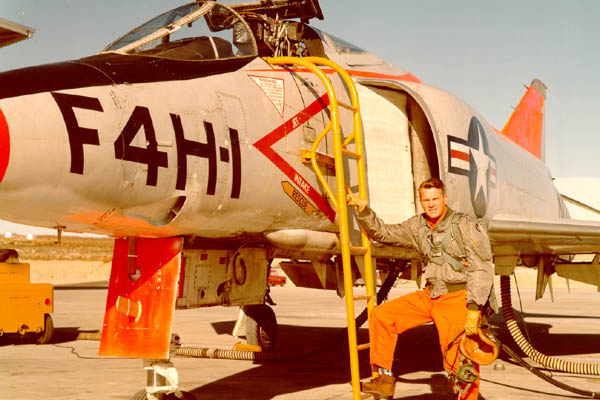
![]() 27 May 1958: At Lambert Field, St. Louis, Missouri, McDonnell Aircraft Corporation’s Chief Test Pilot (and future company president) Robert C. Little made the first flight of the YF4H-1 prototype. The twin-engine Mach 2+ airplane was the first pre-production model of a new U.S. Navy fleet defense interceptor that would be developed into the legendary F-4 Phantom II fighter bomber.
27 May 1958: At Lambert Field, St. Louis, Missouri, McDonnell Aircraft Corporation’s Chief Test Pilot (and future company president) Robert C. Little made the first flight of the YF4H-1 prototype. The twin-engine Mach 2+ airplane was the first pre-production model of a new U.S. Navy fleet defense interceptor that would be developed into the legendary F-4 Phantom II fighter bomber.
The flight lasted 22 minutes. Little had planned to go supersonic but a leak in a pressurized hydraulic line caused him to leave the landing gear extended as a precaution, should the back-up hydraulic system also have a problem. This limited the maximum speed of the prototype to 370 knots (426 kilometers per hour). A post-flight inspection found foreign-object damage to the starboard engine.
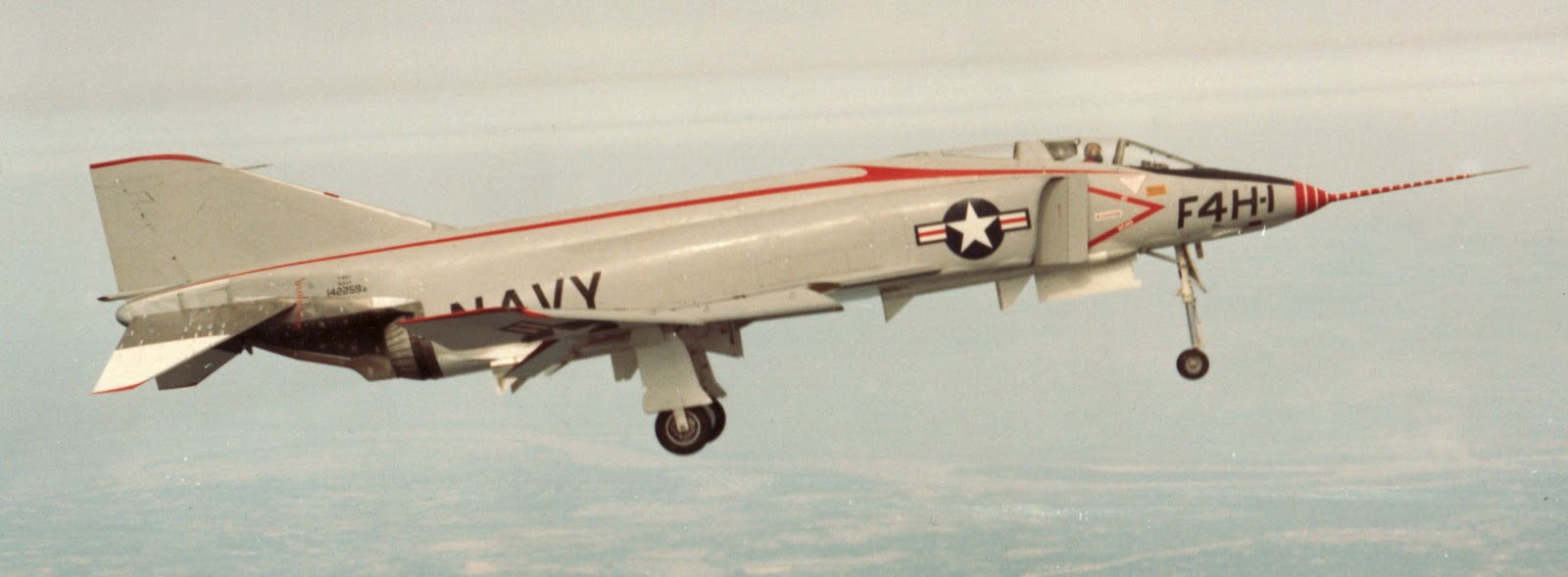
Initially designated XF4H-1 and assigned Bureau of Aeronautics serial number (“Bu. No.”) 142259, the identifier was changed to YF4H-1. It had been in development for over five years based on a company proposal to the Navy.
The McDonnell YF4H-1 Phantom II was 56 feet, 7.9 inches (17.271 meters) long with a wingspan of 38 feet, 4.89 inches (11.707 meters) and overall height of 16 feet, 3.0 inches (4.953 meters). With wings folded, the airplane’s span was narrowed to 27 feet, 6.6 inches (8.397 meters). The wings were swept 45° at 25% chord. The inner wing had no dihedral, while the outer panels had 12° dihedral. The stabilator had a span of 16 feet, 5.0 inches (5.004 meters), with -23.25° anhedral. The wheelbase of Phantom II’s tricycle undercarriage was 23 feet, 3.25 inches (7.093 meters), with a main wheel tread of 17 feet, 10.46 inches (5.447 meters).
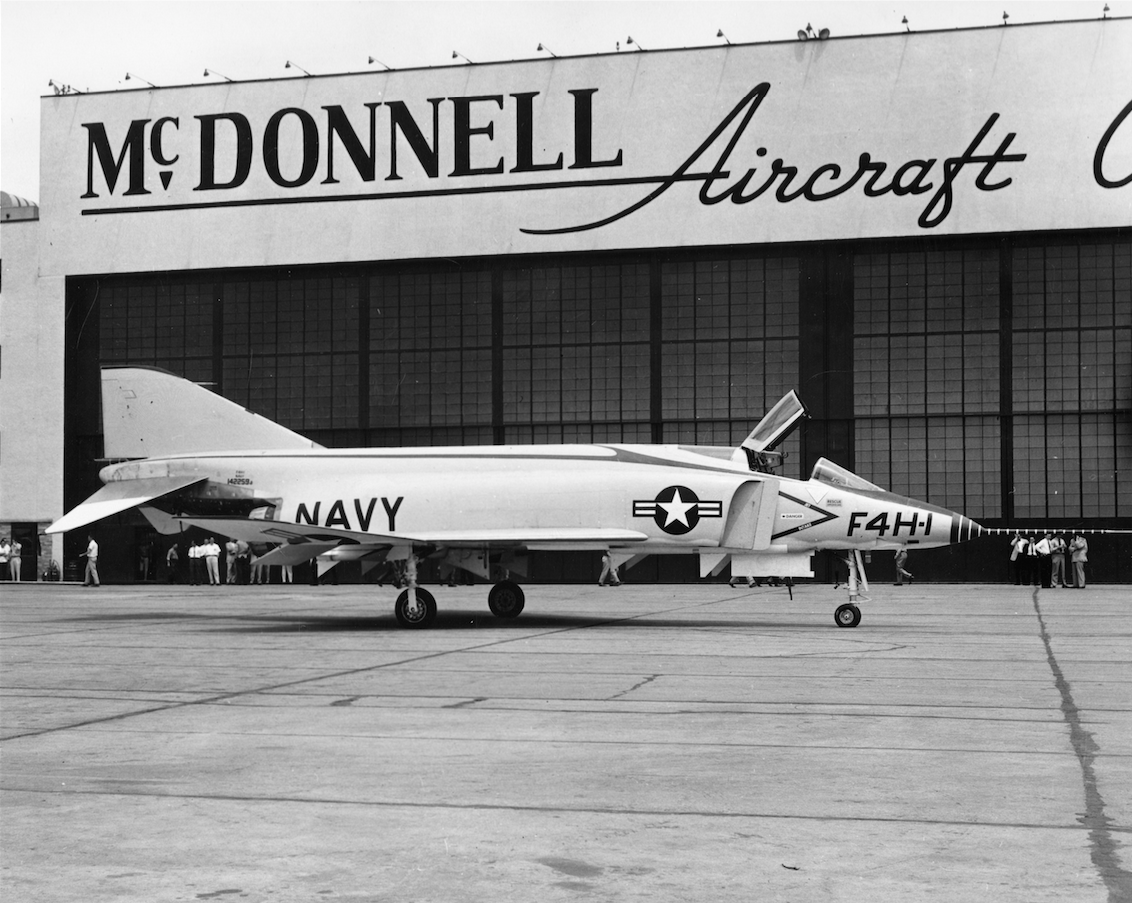
The YF4H-1 prototype was powered by two General Electric J79-GE-2 engines. These were single-spool, axial-flow turbojet engines with a 17-stage compressor and 3-stage turbine. The J79-GE-2 was rated at 10,350 pounds of thrust (46.039 kilonewtons), and 16,150 pounds (71.389 kilonewtons) with afterburner. The engines were 17 feet, 4.0 inches (5.283 meters) long, 3 feet, 2.3 inches in diameter (0.973 meters), and each weighed 3,620 pounds (1,642 kilograms).
The production F4H-1 (F-4B) had a maximum speed of 845 miles per hour (1,360 kilometers per hour) at Sea Level and 1,485 miles per hour (2,390 kilometers per hour) at 48,000 feet (14,630 meters meters). (Mach1.11 and Mach 2.25, respectively). The service ceiling was 62,000 feet (18,898 meters) and maximum range with external fuel was 2,300 miles (3,700 kilometers).
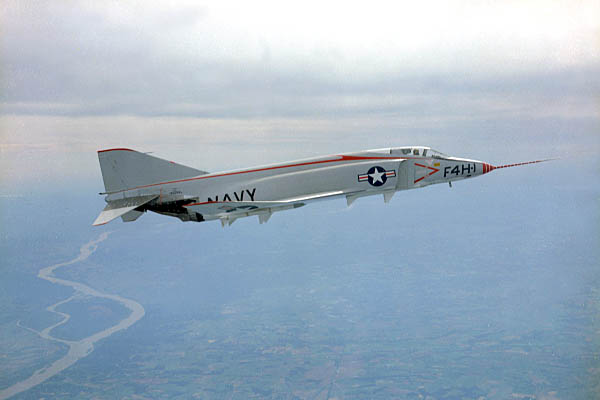
The second prototype YF4H-1, Bu. No. 142260, flown by Commander Lawrence E. Flint, Jr., USN, set a Fédération Aéronautique Internationale (FAI) World Record for Altitude, 6 December 1959, when it zoom-climbed to 30,040 meters (98,556 feet).¹ On 22 November 1961, flown by Lieutenant Colonel Robert B. Robinson, USMC, 142260 also set an FAI World Record for Speed over a Straight 15/25 Kilometer Course, averaging 2,585.425 kilometers per hour (1,606.509 miles per hour).² On 5 December 1961, the same Phantom set an FAI World Record for Altitude in Horizontal Flight at 20,252 meters (66,444 feet) with Commander George W. Ellis, USN, in the cockpit.³
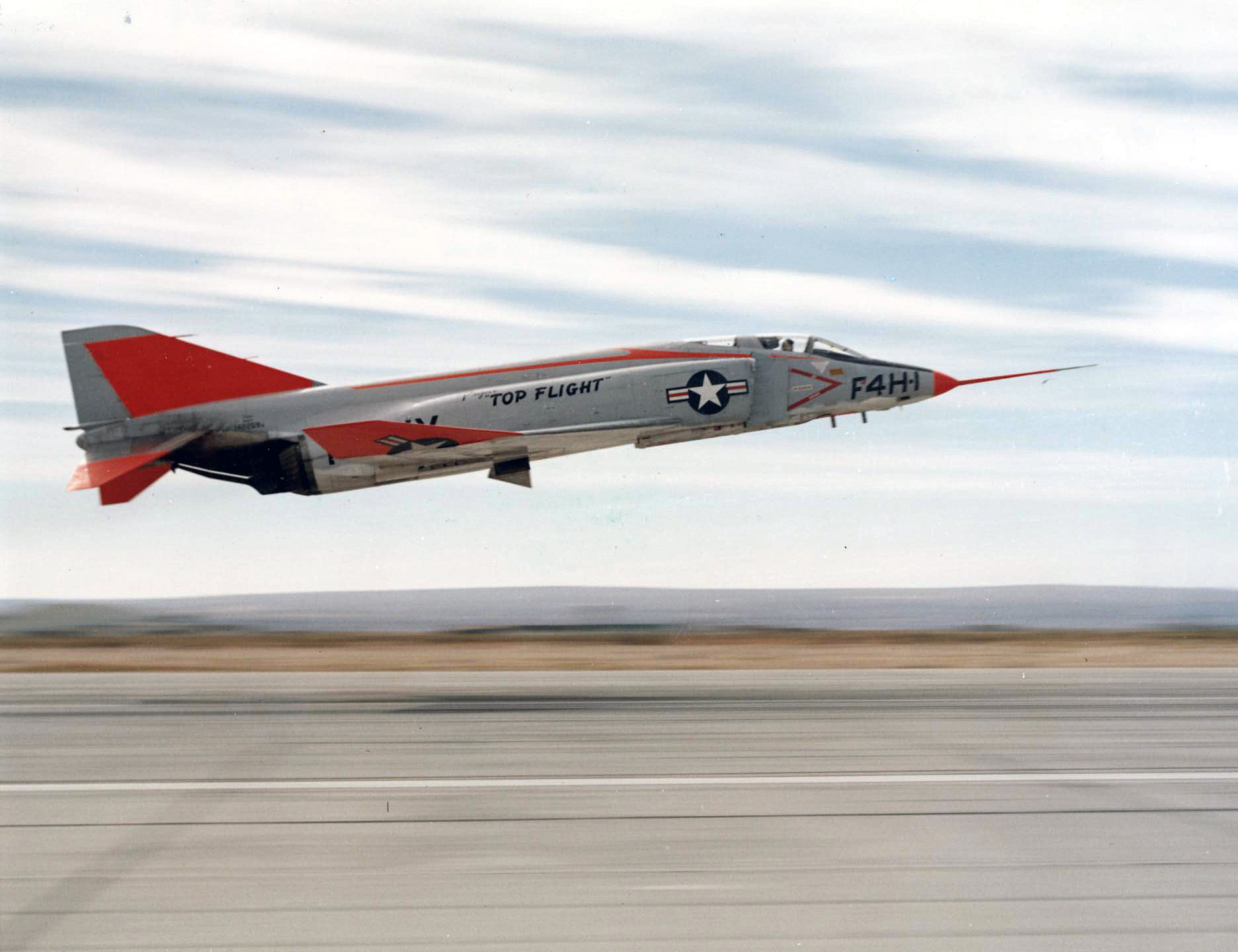
The F-4A through F-4D Phantoms were armed with four AIM-7 Sparrow radar-homing air-to-air missiles, and could carry additional Sparrows or AIM-9 Sidewinder infrared-homing missiles on pylons under the wings. Up to 16,000 pounds (7,257 kilograms) of bombs could be carried on five hardpoints.
McDonnell Aircraft built two YF4H-1 prototypes, followed by 45 F4H-1F (F-4A) Phantom IIs before the F-4B was introduced in 1961. 649 F-4Bs were produced. The initial U.S. Air Force variant was the F-110A Spectre (F-4C Phantom II). McDonnell Douglas delivered its last Phantom II, an F-4E-67-MC, on 25 October 1979. In 21 years, the company had built 5,057 Phantom IIs.

After 11 test flights at St. Louis, Bob Little flew the YF4H-1 west to Edwards Air Force Base in the high desert of southern California where more detailed flight testing and evaluation took place.
On 21 October 1959, a failure of an engine access door led to a cascading series of problems which resulted in the loss of the airplane and death of the pilot, Gerald “Zeke” Huelsbeck.
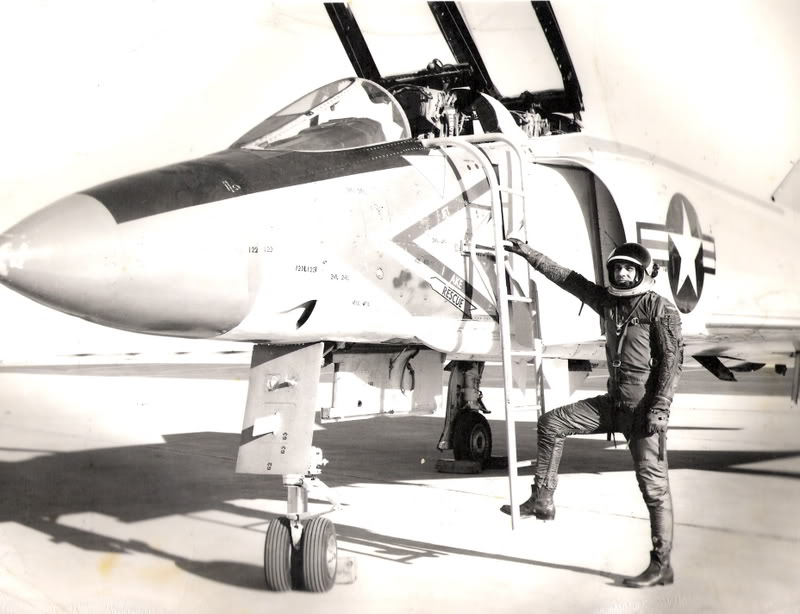
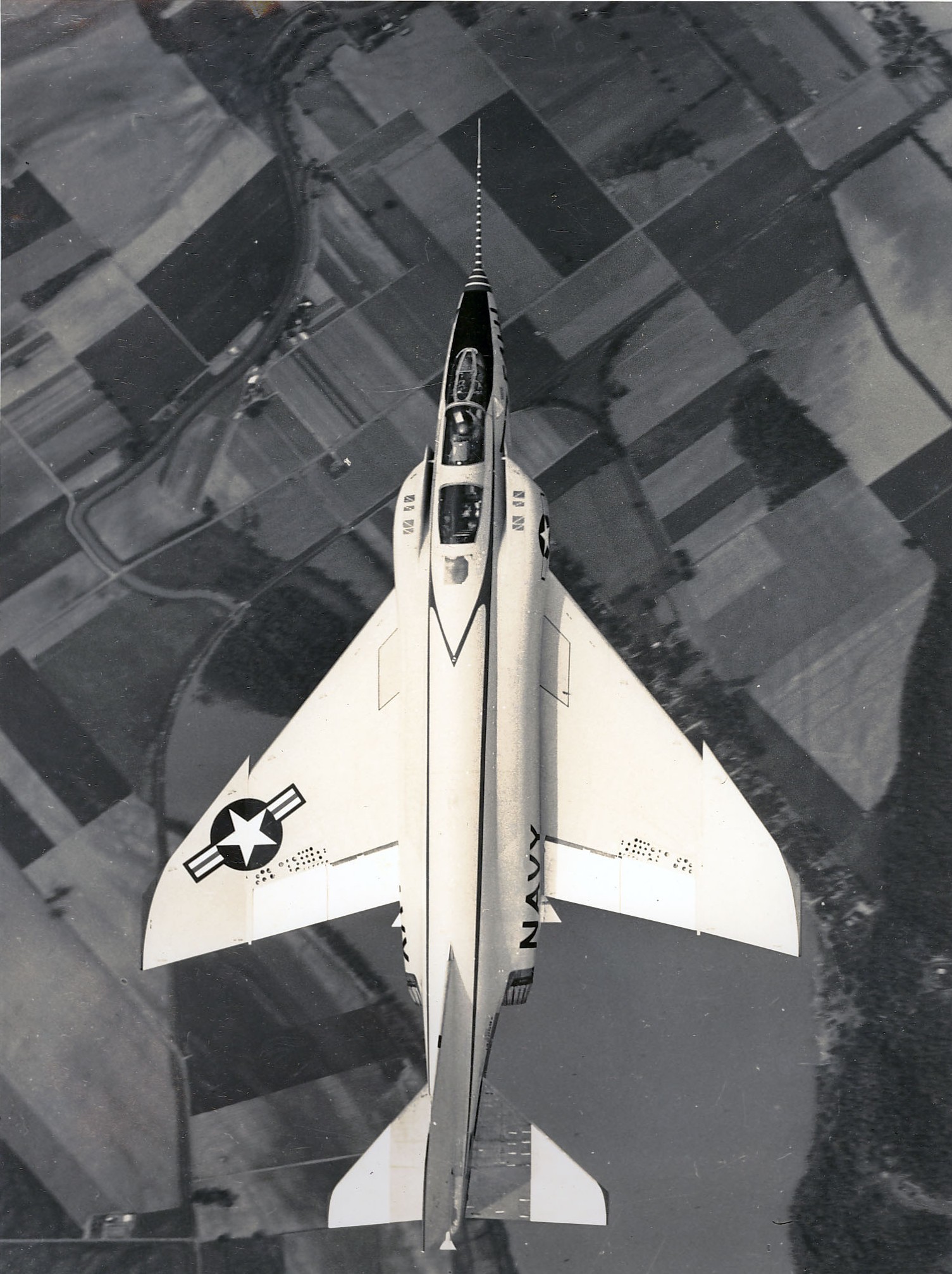
¹ FAI Record File Number 10352
² FAI Record File Number 9060
³ FAI Record File Number 8535
© 2019, Bryan R. Swopes
Happy Birthday F4H-1 Phantom and the two GE J79 Turbojet Engines that powered the aircraft. Today 7 decades later the J79 engines are still supporting military missions around the World with Reliability and maintainability proving the Quality of the GE original design which took the aviation world into new eras using the GE variable vane technology developed by the Gerhard Neumann GE engineering team.
Thanks, Mr. Solon. . . A few days ago, I passed the former George AFB and the airplanes closest to the roadway were two of General Electric’s Boeing 747 aircraft engine test platforms. Keep ’em turnin’ and burnin’!!!
Happy birthday F-4 Phantom!!! I’m very proud that I started my carrier as a mechanic on flight control and hydraulic systems on this beautiful flight machine…still flying still rocking at Hellenic Air Force!!
Thank you, Mr. Tilemachos. I believe that Polemikí Aeroporía still flies 12 RF-4E and 34 modernized F-4E-PI2000 Phantom IIs.
Happy Birthday Phantom,there will never be a figther that stay longer than you in service, always the BEST
Worked for McDonnell from 66 to 68. Building 101.
Did you know my Dad? John Gerhardt. He worked in dept E132.
The birthday reminds us of a special aircraft that included new designs and capabilities. The last of the “muscle car” design built for speed with less focus on turning capability with such a high wing loading.
The last flight by a Navy aircraft may have been a QF-4 flown down to North Is for loading onboard the Midway museum. Fabulous run!
My Baby, I was the Navy’s Weapon Systems Manager for the F-4 in the late 70s. We still had about 500 F-4s and in the middle of the J to S SLEP/Conversion at the time. Some of the happiest days of my life. I have flown 64 different T/M/S acft and the Phantom is still my favorite!
Three fighter squadrons; 3 carrier deployments; 288 combat missions; 900 + Cats and traps: She took me out and brought me back every time. Without breaking a sweat.
“There isn’t any woman and there isn’t any horse, that is as lovely as a great airplane. And men who love them are faithful to them even though they leave them for others. Man has one virginity to lose in fighters and, if it is a lovely airplane he loses it to, there is where his heart will forever be. “ E. Hemingway
She was a beast! What an awesome aircraft!
I had the privilege of flying 9 different versions of the F-4. I shot down two airplanes i n Vietnam with it. Flew 350 missions. Shot down on a Hanoi strike the F-4 got me to the mountains and rescue. While doing operational test at St. Louis Mr. Mac would come up on the 1MC had pump up the troops. I was there for the 5,000 airplane and got to fly it to 85,000.
Thank you, Admiral. I appreciate your visiting This Day in Aviation.